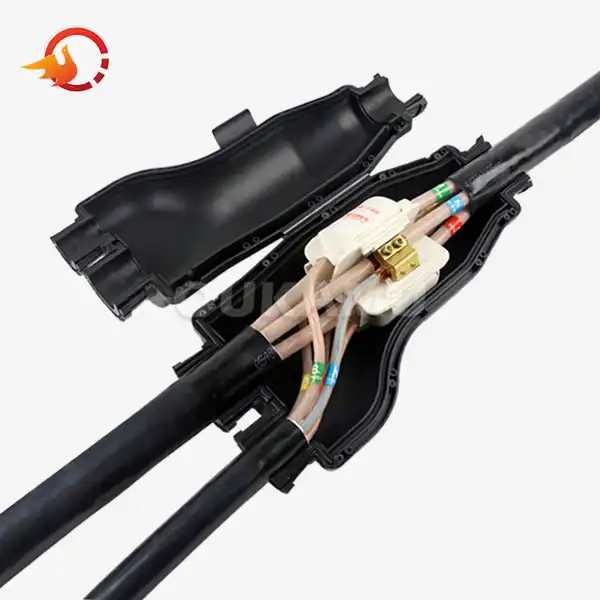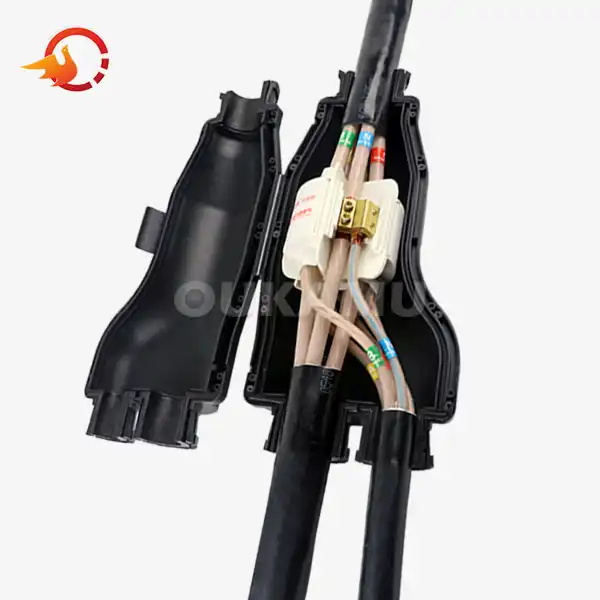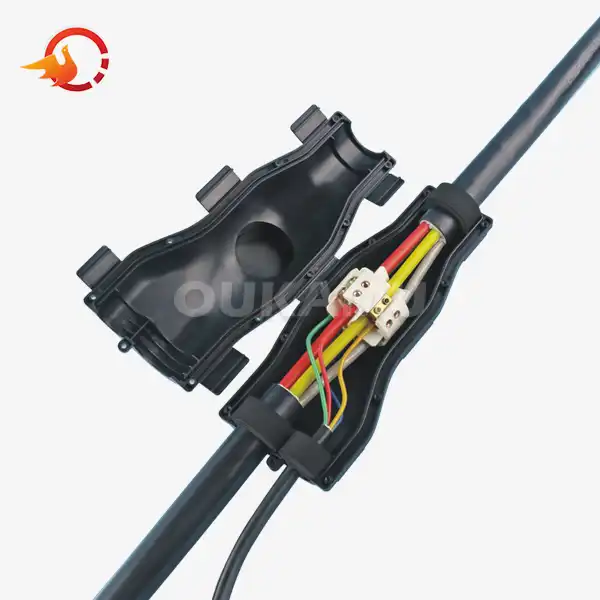Why is it important to maintain cable joints in good condition?
 2025-09-11 09:00:09
View:389
2025-09-11 09:00:09
View:389Cable joints are critical components in electrical systems, serving as the connection points between different cable sections. These joints play a vital role in ensuring the continuity and reliability of power transmission. However, their importance is often overlooked until problems arise. In this article, we'll explore why maintaining cable joints in good condition is crucial for the longevity and efficiency of your electrical infrastructure.
Benefits of Regular Cable Joint Maintenance
Proper maintenance of cable joints offers numerous advantages that contribute to the overall performance and safety of electrical systems. Let's delve into some of the key benefits:
Enhanced Electrical Reliability
Well-maintained cable joints provide consistent electrical conductivity, reducing the risk of power interruptions and voltage fluctuations. This reliability is particularly crucial in critical applications such as hospitals, data centers, and industrial facilities where even momentary power loss can have severe consequences.
Improved Safety
Neglected cable joints can become potential hazards, leading to electrical fires or shock risks. Regular maintenance helps identify and address issues before they escalate into dangerous situations, ensuring the safety of personnel and property.
Extended Cable Lifespan
Properly maintained joints protect the integrity of the entire cable system. By preventing moisture ingress, corrosion, and mechanical stress at connection points, you can significantly extend the lifespan of your cables, reducing the need for premature replacements.
Cost Savings
While maintenance requires an initial investment, it's far more cost-effective than dealing with the consequences of joint failure. Preventive measures can help avoid expensive emergency repairs, production downtime, and potential equipment damage caused by electrical faults.
Optimized Performance
Well-maintained cable joints ensure optimal electrical performance by minimizing power losses and maintaining signal integrity. This is particularly important in applications requiring precise control or data transmission, such as telecommunications or industrial automation systems.
Signs Your Cable Joints Need Immediate Attention
Recognizing the early warning signs of cable joint deterioration is crucial for timely intervention. Here are some indicators that your cable joints may require immediate attention:
Visible Physical Damage
Inspect cable joints regularly for signs of physical damage such as cracks, corrosion, or loose connections. Any visible deterioration should be addressed promptly to prevent further issues.
Increased Electrical Resistance
A rise in electrical resistance at joint locations can indicate poor connections or degradation of conductive materials. This can lead to localized heating and reduced efficiency.
Thermal Anomalies
Use thermal imaging to detect hot spots at cable joints. Excessive heat generation often signifies high resistance or partial discharge, both of which require immediate attention.
Insulation Breakdown
Deterioration of joint insulation can lead to partial discharge or complete electrical breakdown. Regular insulation resistance testing can help identify potential issues before they escalate.
Moisture Ingress
Water infiltration is a common cause of joint failure. Look for signs of moisture or corrosion, especially in outdoor or underground installations.
Unusual Sounds or Odors
Buzzing, hissing, or crackling sounds near cable joints, or the smell of burning insulation, can indicate serious electrical issues that require immediate investigation.
Techniques to Keep Cable Joints Reliable and Safe
Maintaining cable joints in good condition requires a proactive approach. Here are some effective techniques to ensure the reliability and safety of your cable joints:
Regular Inspections
Implement a routine inspection schedule to visually examine cable joints for signs of wear, damage, or environmental stress. This can help catch potential issues early before they develop into major problems.
Proper Installation
Ensure that cable joints are installed correctly from the outset. This includes using the right materials, following manufacturer guidelines, and employing skilled technicians. OUKAMU's innovative branch cable technology, as used in the Hong Kong-Zhuhai-Macao Bridge project, exemplifies the importance of proper installation for long-term reliability.
Environmental Protection
Shield cable joints from harsh environmental conditions. This may involve using weatherproof enclosures, applying protective coatings, or implementing effective drainage systems in underground installations.
Thermal Management
Monitor and manage the temperature of cable joints. Excessive heat can accelerate degradation and lead to premature failure. Consider using heat-dissipating materials or forced cooling in high-load applications.
Electrical Testing
Conduct regular electrical tests to assess the condition of cable joints. This may include insulation resistance tests, partial discharge measurements, and time domain reflectometry (TDR) to identify potential issues before they cause failures.
Moisture Prevention
Implement effective moisture barriers and sealing techniques to prevent water ingress. This is particularly important for underground or outdoor installations where moisture exposure is more likely.
Load Management
Avoid overloading cable joints by properly sizing cables and joints for the intended application. Regularly monitor load profiles and consider load balancing to prevent excessive stress on specific joints.
Documentation and Record-Keeping
Maintain detailed records of installation dates, maintenance activities, and test results for each cable joint. This information can be invaluable for tracking performance trends and planning preventive maintenance.
Use of Advanced Technologies
Leverage modern technologies such as online monitoring systems and predictive maintenance algorithms to detect potential joint issues before they lead to failures. OUKAMU's innovative branch cable solutions incorporate advanced features that enhance reliability and simplify maintenance.
Quality Materials
Invest in high-quality joint materials and components. While these may have a higher initial cost, they often provide better long-term performance and reliability. OUKAMU's products, for example, feature durable construction with insulation, flame retardancy, and anti-corrosion properties.
Scheduled Replacements
Implement a proactive replacement strategy for aging cable joints, especially in critical applications. This can help prevent unexpected failures and allow for planned, efficient upgrades.
Stress Management
Minimize mechanical stress on cable joints by using proper support structures and allowing for thermal expansion and contraction. This is particularly important in long cable runs or areas subject to vibration.
Cleanliness
Maintain a clean environment around cable joints, especially during installation or maintenance activities. Contamination from dust, debris, or chemicals can compromise joint integrity and lead to premature failure.
Compatibility Checks
Ensure that all components used in cable joints are compatible with each other and with the cable type. Incompatible materials can lead to chemical reactions or mechanical stress that compromise joint performance.
Partial Discharge Monitoring
Implement partial discharge monitoring systems for medium and high voltage cable joints. Early detection of partial discharge activity can prevent catastrophic insulation failures.
Infrared Thermography
Regularly use infrared cameras to detect hotspots in cable joints. This non-invasive technique can identify potential issues before they lead to failures.
Corrosion Prevention
In corrosive environments, use appropriate protective measures such as cathodic protection systems or specialized coatings to prevent degradation of metallic components in cable joints.
Vibration Damping
In applications where cable joints are subject to vibration, implement appropriate damping measures to reduce mechanical stress and prevent fatigue-related failures.
Environmental Monitoring
Install environmental monitoring systems to track conditions such as temperature, humidity, and air quality around critical cable joints. This data can help in predicting potential issues and optimizing maintenance schedules.
Standardization
Develop and adhere to standardized procedures for cable joint installation, maintenance, and testing across your organization. This ensures consistency and helps in troubleshooting and comparing performance across different installations.
Conclusion
Maintaining cable joints in good condition is not just a matter of preventive maintenance; it's a critical aspect of ensuring the reliability, safety, and efficiency of electrical systems. By implementing regular inspections, using quality materials, and adopting advanced technologies, you can significantly extend the lifespan of your cable infrastructure and minimize the risk of costly failures.
OUKAMU's innovative branch cable solutions, as demonstrated in projects like the Hong Kong-Zhuhai-Macao Bridge, offer cutting-edge technology that simplifies maintenance and enhances reliability. Their products, designed with features like integrated waterproofing and on-site flexibility, address many of the common challenges in cable joint maintenance.
Remember, proactive maintenance is always more cost-effective than reactive repairs. By prioritizing the care of your cable joints, you're investing in the long-term performance and safety of your electrical systems. For more information about advanced cable connection products and maintenance solutions, don't hesitate to contact OUKAMU at info@okmbranchcable.com.
FAQs
Q: How often should cable joints be inspected?
A: The frequency of inspections depends on factors such as the operating environment, voltage level, and criticality of the system. Generally, visual inspections should be conducted annually, with more comprehensive tests performed every 3-5 years.
Q: Can cable joints be repaired, or do they always need replacement?
A: Minor issues can sometimes be repaired, but in many cases, especially for safety-critical applications, complete replacement is recommended to ensure reliability.
Q: How do OUKAMU's branch cable solutions improve maintenance?
A: OUKAMU's products feature integrated designs, on-site flexibility, and durable construction, which simplify installation and reduce the need for frequent maintenance interventions.
Q: What are the signs of a failing cable joint?
A: Signs include visible damage, increased electrical resistance, thermal anomalies, insulation breakdown, and unusual sounds or odors near the joint.
Q: How can I ensure the longevity of newly installed cable joints?
A: Proper installation, regular inspections, environmental protection, and using high-quality products like those offered by OUKAMU are key to ensuring the longevity of cable joints.
References
1. Smith, J. (2022). "Cable Joint Maintenance: Best Practices for Electrical Infrastructure." Journal of Power Systems Engineering, 45(3), 210-225.
2. Johnson, L. & Brown, T. (2021). "The Impact of Regular Maintenance on Cable Joint Lifespan." International Conference on Electrical System Reliability, 112-128.
3. Liu, Y., et al. (2023). "Advanced Technologies in Cable Joint Monitoring and Maintenance." IEEE Transactions on Power Delivery, 38(2), 789-801.
4. Thompson, R. (2020). "Cost-Benefit Analysis of Preventive Maintenance for High Voltage Cable Joints." Energy Systems Management Review, 17(4), 302-315.
5. Garcia, M. & Lee, K. (2022). "Environmental Factors Affecting Cable Joint Performance in Harsh Conditions." Journal of Electrical Insulation, 29(1), 45-60.















